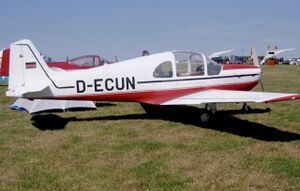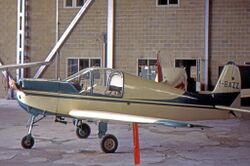Engineering:Ambrosini Rondone
| Ambrosini Rondone | |
|---|---|

| |
| F.7 Rondone II at an aircraft rally at Schaffen-Diest airfield (Belgium) in August 2009 | |
| Role | Light touring monoplane |
| National origin | Italy |
| Manufacturer | SAI Ambrosini |
| Designer | Ing. Stelio Frati |
| First flight | 1951 |
| Introduction | 1951 |
| Status | Still in service |
| Number built | 20 |
The Ambrosini Rondone is an Italian-designed two/three-seat light touring monoplane of the early 1950s.
Development
The Rondone was created to satisfy the demand for a more contemporary touring aircraft from Italian private pilots and aero clubs. Stelio Frati prepared the basic design for the prototype two-seat F.4 Rondone I[1] which was built by CVV in 1951. This was followed by nine production examples produced by SAI Ambrosini in collaboration with Aeronautica Lombardi.[2]
The three-seat F.7 Rondone II first flew on 10 February 1954 and the prototype and nine production examples were built for Ambrosini by Legnami Pasotti.[2]
The Rondone is of conventional wooden construction with a plywood-covered one-piece single spar wing and a monocoque fuselage. The tricycle undercarriage is retractable. Two-position flaps and dual controls are fitted. The Rondone II has an extended cabin with additional rear side windows.[1]
Operational history
The Rondone was initially mainly sold to individuals and clubs in Italy, but examples later served in France and Germany. Several were still operational in 2009.
Variants
- F.4 Rondone I prototype
- Two-seater with a 65 hp (48 kW) Walter Mikron III. 1 built.[3]
- F.4 Rondone I production aircraft
- Two-seater with an 85 hp (63 kW) Continental C-85 or 90 hp (67 kW) Continental C-90. 10 built.[3]
- F.7 Rondone II
- Three-seater with a 90 hp (67 kW) Continental C90 or 135 hp (101 kW) Lycoming O-290-D2 engine.[4][5] 10 built from new plus one converted from a F.4. Some were later fitted with a 100 hp (75 kW) Continental O-200 engine.[4]
Specifications (F.7 Rondone II with Lycoming engine)
Data from Jane's All the World's Aircraft 1956-57[5]
General characteristics
- Crew: 1
- Capacity: 3 passengers (Lycoming engine)
- Length: 6.80 m (22 ft 4 in)
- Wingspan: 9.30 m (30 ft 6 in)
- Height: 2.26 m (7 ft 5 in) [2]
- Wing area: 10.6 m2 (114 sq ft)
- Aspect ratio: 6.6
- Empty weight: 530 kg (1,168 lb)
- Gross weight: 900 kg (1,984 lb)
- Fuel capacity: 142 L (37.5 US gal; 31.2 imp gal) in three fuselage tanks
- Powerplant: 1 × Lycoming O-290-D2 4-cylinder air-cooled horizontally-opposed piston engine, 101 kW (135 hp)
- Propellers: 2-bladed fixed-pitch propeller
Performance
- Maximum speed: 265 km/h (165 mph, 143 kn)
- Cruise speed: 233 km/h (145 mph, 126 kn) [2]
- Stall speed: 75 km/h (47 mph, 40 kn)
- Range: 700 km (430 mi, 380 nmi)
- Service ceiling: 4,500 m (14,800 ft)
- Rate of climb: 4.3 m/s (850 ft/min) [2]
- Wing loading: 68 kg/m2 (14 lb/sq ft)
- Power/mass: 0.0786 kW/kg (0.0478 hp/lb)
- Take-off run: 130 m (427 ft)
- Landing run: 100 m (328 ft)
References
- Bibliography
- "Aircraft of European Civil Registers: 3 : The designs of Stelio Frati". Archive (Air-Britain) (3). 1982. ISSN 0262-4923.
- Bridgman, Leonard, ed (1956). Jane's All the World's Aircraft 1956-57. London: Sampson Low, Marston & Company, Ltd.
- Green, William (1955). The Aircraft of the World. Macdonald and Co. (Publishers) Ltd.
- Simpson, Rod (2001). Airlife's World Aircraft. Airlife Publishing Ltd. ISBN 1-84037-115-3.
 |


